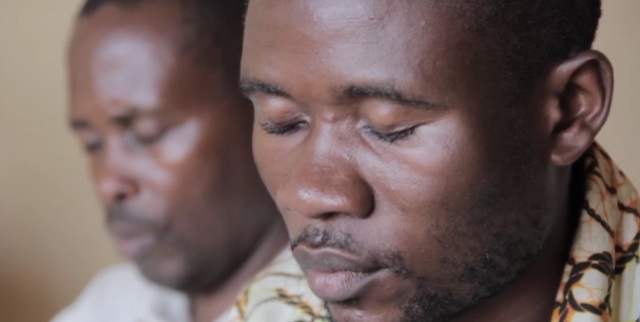
Although the Democratic Republic of Congo (DRC) had been at war for decades, Pamela, her husband, and children had managed to avoid the conflicts that had already killed six million Congolese.
Living in the warring state of Kivu could mean a rapid change in fortunes. Despite years of comfortable food and dress, with a loving husband and family, her fortunes changed one day in 2008 when a large group of soldiers barged into her home.
“They took my husband, and I was left in the bedroom. There were six soldiers that I saw. One soldier started to touch me. When I refused, he hit me on the head. I fell to the ground. I gave them jewelry, but that was not enough for them. They started to rape me. I couldn’t stand it any more. I fainted.”
‘Meanwhile, in the living room, they had already killed my husband.”
After the soldiers returned eight months later, Pamela fled with some her children to Kampala, Uganda. In the escape, some of her children got separated from her. Here, she hoped to begin a new life. But she kept getting threatening notes from enemies in Congo: “Kampala is no heaven. It is no haven. We will find you.” And the horrors of Pamela’s past haunted her day and night. She slept fitfully and wept uncontrollably.
“Before, if someone was to tell me of a problem, I would panic. My heart would race. I had no peace of mind. I also did not sleep since 2008,” Pamela said.
Pamela was suffering from post-traumatic stress disorder (PTSD). Symptoms of PTSD include flashbacks, persistent fear, uncontrollable anger, depression, insomnia, drug abuse, feelings of hopelessness, and more. Victims of PTSD often become incapable of caring for themselves or their families.
Pamela was not alone in the challenges that she faced. African PTSD Relief estimates that up to 100 million Africans suffer from PTSD. These men and women have experienced the trauma of war, terrorism, violence, sexual abuse, or natural disasters.
A Glimmer of Light
In Uganda, Pamela’s life took an unexpected twist. I had put together a research team including Dr. Brian Rees, a Medical Doctor and Colonel in the army with five tours of duty in Iraq and Afghanistan who was a military expert in PTSD, Dr. Fred Travis, an experienced statistician, and myself.
We welcomed Congolese war refugees with high levels of PTSD symptoms to join a test to see what kind of effect Transcendental Meditation would have on PTSD. Pamela received the invitation, joined the study, and learned Transcendental Meditation.
Transcendental Meditation (T.M.) is a simple, natural technique that involves sitting with eyes closed for 20 minutes twice a day. The technique releases stresses from one’s physiology, creating a unique state of deep relaxation. T.M. supports healthy, coherent cognitive functioning. The practice is not linked to any doctrine, religion, or philosophy.
In May, 2011, Pamela’s brother said, “Come with me. They are teaching meditation. He knew I was at the end of my rope, and my head was not working right.”
Hoping for an improved quality of life for herself and her children, Pamela agreed to learn T.M.
Rapid Improvement
Within 30 days of beginning Transcendental Meditation (T.M.), Pamela noticed a profound change in herself.
“Since I got all of these problems in 2008, it is only now, after meditating, that I am functioning normally again. My hearing is back. Before now, I could not sleep for days on end. Now I can sleep again.”
“Before, I would think constantly about my children who are lost, and I do not know where they are. I used to think I should die, too. I thought I could not go on living anymore.”
“I am so happy to meditate. After I hear of a problem, in my next meditation, right way I feel myself relax and calm down.”
“With T.M., things are better. It helped me tremendously.”

Scientific Evidence
Was Pamela’s response to T.M. typical, or was it an anomaly? A 2013 study involving Congolese refugees shed light on the issue.
African PTSD Relief decided to sponsor an experiment. They taught T.M. to 21 Congolese refugees, with 21 others serving as a control group. All of the refugees suffered from high levels of PTSD.
The study took place over a period of 135 days. Within 30 days of practicing T.M., 90 percent of the participants had reached “non-symptomatic levels” of PTSD. These levels remained low for the rest of the study. By contrast, the non-meditating control group did not show any reduction in symptoms.
Colonel Brian Rees was impressed by the outcome of the two studies. “We anticipated improvement, but I didn’t expect this magnitude of change,” says Rees, the lead author of the studies. “The continued improvement at four months also led us to conclude that T.M. may be a very worthwhile intervention for anyone suffering from post-traumatic stress disorder.”
T.M.: A Cure for PTSD? Does it Restore Resilience?
Will T.M. become a standard treatment for PTSD? Dr. Travis shares his thoughts.
“If the scientific community pays attention to the ongoing research,” he said in an interview, “they cannot help but seriously consider Transcendental Meditation as an intervention to address post-traumatic stress.”
I had practiced Transcendental Meditation for 35 years and knew it was an effective tool for stress reduction in general. Now, having seen that Transcendental Meditation can produce such a dramatic and rapid relief from chronic, debilitating traumatic stress, PTSD, in this group in just 30 days, I formed PTSD Relief Now and its African PTSD Relief projects to help the 100 million Africans and the hundreds of millions of victims of trauma around the world come rapidly out of this debilitating disorder.
Thousands of Africans have been helped in schools, orphanages, widows groups, and the general population in Kenya, Tanzania, South Africa, South Sudan, Uganda, Congo, and other areas of the continent. Over 100,000 Africans have asked for support. Now, for $25-$100 for the first year, an African with post-traumatic stress can return to a normal and productive life.
Most victims of war, civilians and soldiers, sexual and physical assault victims, and all those suffering from chronic traumatic stress find rapid reduction in symptoms with this tool. Those who are employing other PTSD reduction tools may add on Transcendental Meditation to accelerate the healing process.
T.M. is bringing hope to those suffering from past traumas. Pamela, for one, appreciates the renewed resilience and joy this technique provides. It has brought her from trauma to tranquility.
Speaking of T.M., she says, “Before, I could not imagine being able to take care of my children. I imagined I would die, leaving them behind.
That is why I am so happy about T.M.; it has saved me.”
*Note: because of ongoing threats to Pamela’s life, her name has been changed in this article.
Please see the bio below for ways to help.
~
~
~
Authors: David Shapiro & Krista Noble
Image: Courtesy of Author
Editor: Travis May
Copy editor: Khara-Jade Warren
Social editor: Yoli Ramazzina
Ready to join?
Hey, thanks so much for reading! Elephant offers 1 article every month for free.
If you want more, grab a subscription for unlimited reads for $5/year (normally, it's $108/year, and the discount ends soon).
And clearly you appreciate mindfulness with a sense of humor and integrity! Why not join the Elephant community, become an Elephriend?
Your investment will help Elephant Journal invest in our editors and writers who promote your values to create the change you want to see in your world!
Already have an account? Log in.
Ready to join?
Hey, thanks so much for reading! Elephant offers 1 article every month for free.
If you want more, grab a subscription for unlimited reads for $5/year (normally, it's $108/year, and the discount ends soon).
And clearly you appreciate mindfulness with a sense of humor and integrity! Why not join the Elephant community, become an Elephriend?
Your investment will help Elephant Journal invest in our editors and writers who promote your values to create the change you want to see in your world!
Already have an account? Log in.
Ready to join?
Hey, thanks so much for reading! Elephant offers 1 article every month for free.
If you want more, grab a subscription for unlimited reads for $5/year (normally, it's $108/year, and the discount ends soon).
And clearly you appreciate mindfulness with a sense of humor and integrity! Why not join the Elephant community, become an Elephriend?
Your investment will help Elephant Journal invest in our editors and writers who promote your values to create the change you want to see in your world!
Already have an account? Log in.
 Share on bsky
Share on bsky





Read 1 comment and reply